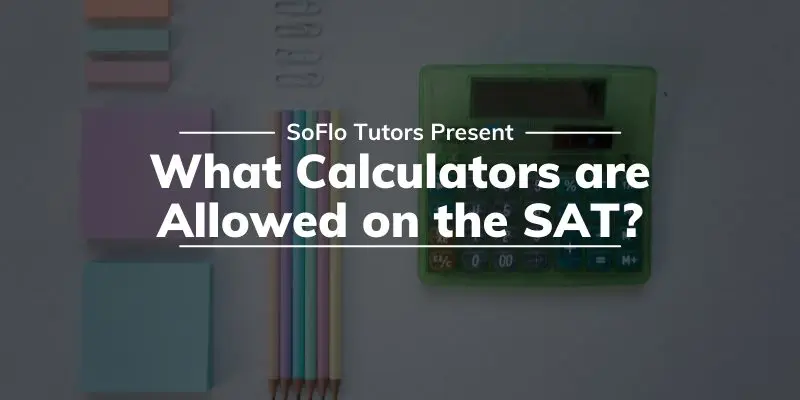
SAT Allowed Calculators
Preparing for and taking the SAT can be a very lengthy, involved, and important process for many high school and other students across the country and across the world.
Since SAT scores can play one of the largest roles in determining what colleges and universities any given student gains admission to, as well as what college scholarship opportunities any given student has, it is extremely important for every student planning on applying to colleges and universities to take the SAT preparation process seriously.
Naturally, math can be much easier with a calculator, so many students taking the SAT find themselves asking: “Are calculators allowed on the SAT?” and “What calculators are allowed on the SAT?”
In this article, we will discuss the acceptable calculators for the SAT, calculators allowed on the SAT, and the SAT calculator policy, among related topics regarding calculators and the SAT.
When are Calculators Allowed on the SAT?
The first question a student may find themselves asking pertaining to the topic of SAT permitted calculators and what calculators are allowed on the SAT is: “Are calculators allowed on the SAT, and if so, when are calculators allowed on the SAT?”
Of course, before you know what calculators are allowed on the SAT, you have to know when calculators are allowed on the SAT. You can have and use an approved calculator on the Math Calculator section of the SAT, and only on that section.
When you get to the Math Calculator section, you’ll know! It will be clearly indicated on your test booklet, both in bold writing at the top of the page and by the presence of a calculator icon.
Under no circumstances can you use any calculator, approved or otherwise, on any other section of the SAT. This means you cannot use a calculator on the Math No Calculator section of the SAT (which will be clearly indicated as such by bold writing at the top of the page in your test booklet and a crossed out calculator icon) or on any of the non-math sections of the SAT, such as Writing & Language and Reading.
Except for the Math Calculator section, a calculator cannot even be present on your desk during the SAT. If you have your calculator out during the No Calculator section, your proctor might even invalidate your entire test. However, during the Math Calculator section of the SAT, you can, and absolutely should, have an approved calculator readily available and visible on your desk.
What Type of Calculators are Allowed on the SAT?
Now that you know when you can use an SAT approved calculator on the SAT, you might be asking yourself what an SAT approved calculator is. Specifically, many students may wonder and ask: “What calculators are allowed on the SAT?”
The answer to the question of what calculators are allowed on the SAT can be answered in both general and specific terms, and you absolutely must know both answers.
Keeping in mind that a calculator with one inch or higher characters or a raised display may lead to you being seated at the discretion of the test site coordinator, you can generally use all four-function calculators.
While some questions are still better to solve without a calculator, even on the Math Calculator section (the only section you can use a calculator on), you would almost certainly want to bring something with greater functionality than a four-function calculator if you can). All scientific calculators, and most (but not all) graphing calculators are also allowed on the SAT exam.
To check if your calculator is SAT approved for testing day, check out the list of approved calculators below.
List Of SAT Approved Calculators
Thus far, we have discussed what calculators are allowed on the SAT in a detailed, but general, sense.
Now, going beyond that aspect of the discussion of what calculators are allowed on the SAT (and beyond the question of if calculators are allowed on the SAT, which we already addressed), we will discuss some specific SAT approved calculators.
What will follow is a detailed list of SAT allowed calculators from each of the following brands: Casio, Hewlett-Packard, Radio Shack, Sharp, Texas Instruments, and others. This will give you a more detailed idea of acceptable calculators for the SAT.
Casio Calculators Allowed on the SAT
The following Casio calculator models are acceptable calculators for the SAT, per the College Board’s SAT website:
- FX-6000 series
- FX-6200 series
- FX-6300 series
- FX-6500 series
- FX-7000 series
- FX-7300 series
- FX-7400 series
- FX-7500 series
- FX-7700 series
- FX-7800 series
- FX-8000 series
- FX-8500 series
- FX-8700 series
- FX-8800 series
- Graph25 series
- FX-9700 series
- FX-9750 series
- FX-9860 series
- CFX-9800 series
- CFX-9850 series
- CFX-9950 series
- CFX-9970 series
- FX 1.0 series
- Algebra FX 2.0 series
- FX-CG-10
- FX-CG-20 series
- FX-CG-50
- Graph35 series
- Graph75 series
- Graph95 series
- Graph100 series
- FX-CG-500
Note that stylus use is not permitted on the FX-CG-500 model.
Hewlett-Packard Calculators Allowed on the SAT
The following Hewlett-Packard calculator models are acceptable calculators for the SAT, per the College Board’s SAT website:
- HP-9G
- HP-28 series
- HP-38G
- HP-39 series
- HP-40 series
- HP-48 series
- HP-49 series
- HP-50 series
- HP Prime
Radio Shack Calculators Allowed on the SAT
The following Radio Shack calculator models are acceptable calculators for the SAT, per the College Board’s SAT website:
- EC-4033
- EC-4034
- EC-4037
Sharp Calculators Allowed on the SAT
The following Sharp calculator models are acceptable calculators for the SAT, per the College Board’s SAT website:
- EL-5200
- EL-9200 series
- EL-9300 series
- EL-9600 series
- EL-9900 series
Note that the use of the stylus is not permitted with the EL-9600 series model.
Texas Instruments Calculators Allowed on the SAT
The following Texas Instruments calculator models are acceptable calculators for the SAT, per the College Board’s SAT website:
- TI-73
- TI-80
- TI-81
- TI-82
- TI-83
- TI-83 Plus
- TI-83 Plus Silver
- TI-84 Plus
- TI-84 Plus CE
- TI-84 Plus CE Python
- TI-84 Plus Silver
- TI-84 Plus C Silver
- TI-84 Plus T
- TI-84 Plus CE-T
- TI-84 Plus CE-T Python Edition
- TI-85
- TI-86
- TI-89
- TI-89 Titanium
- TI-Nspire
- TI-Nspire CX
- TI-Nspire CX II
- TI-Nspire CX II-T
- TI-Nspire CM-C
- TI-Nspire CAS
- TI-Nspire CX CAS
- TI-Nspire CX II CAS
- TI-Nspire CX II-T CAS
- TI-Nspire CM-C CAS
- TI-Nspire CX-C CAS
- TI-Nspire CX II-C CAS
Other Calculators Allowed on the SAT
The following Other calculator models are acceptable calculators for the SAT, per the College Board’s SAT website:
- Datexx DS-883
- Micronta
- NumWorks
- Smart2
Calculators That Might get you in Trouble
Now that we’ve presented and discussed a complete list, per the College Board’s SAT website, of what calculators are allowed on the SAT, you may be wondering as to what calculators are disallowed on the SAT, so you can avoid getting in trouble for bringing them on test day.
The College Board’s SAT website notes that the following items are all entirely unacceptable for use as a calculator at any point during an SAT exam:
- Laptops of any kind
- Computers of any kind
- Tablets of any kind
- Mobile phones of any kind
- Smartwatches of any kind
- Any kind of wearable technology
- Any calculator or device that can access the internet
- Any calculator or device with wireless functionality
- Any calculator or device with Bluetooth functionality
- Any calculator or device with cellular functionality
- Any calculator or device with audio recording or video recording capabilities
- Any calculator or device that can play video
- Any calculator or device that has a camera or any other smartphone or smartphone-like feature
- Any calculator with a QWERTY-style keyboard, stylus, or pen input of any kind
- Any calculator model with paper tape, uses an electrical outlet, or makes any kind of noise
- Any stylus, even if with an approved calculator, is not allowed
- Some calculators with touch screen functionality, such as the Casio ClassPad, are not allowed
Tips on Using Calculators for the SAT
Now, through this article, you know what calculators are allowed on the SAT, as well as what calculators are not allowed on the SAT, in a relatively complete sense. However, knowing how to use an acceptable calculator properly is critical to success on the SAT.
In the following sections, we will discuss tips and strategies for how to best use the acceptable calculator of your choice to maximize your success on the SAT math calculator section.
Know When To Use Your Calculator on the SAT Calculator Section
Knowing when to use a calculator is a critical skill that can greatly aid your success on the SAT Math Calculator section. Generally speaking, you should only use a calculator if it will clearly speed you up or increase accuracy on the given question. For example, you might want to use your calculator if the question involves adding, subtracting, multiplying, or dividing large numbers, exponents, and so forth.
However, some questions, even on the Math Calculator section, can be solved more quickly without the use of a calculator. While a calculator can help on some questions in terms of speed and accuracy, it is important to note that every question, even on the Math Calculator section, can technically be solved without the use of a calculator.
Do Not Share Calculators During the SAT
Another rule that is critical for you to know on SAT test day, beyond what calculators are allowed on the SAT, is the fact that sharing calculators is absolutely not allowed on the SAT.
You cannot, under any circumstances, share calculators with another student during the SAT. This is because, beyond the fact that not having your own calculator could put you at risk of not having one at all on test day, the act of sharing calculators could facilitate cheating. You must absolutely bring your own calculator to put yourself in the best possible position for success, and you cannot share it with anyone under any circumstances during SAT test day, even if someone asks you to share.
Practice for the Test Using the Same Calculator You’ll Use on Test Day
Familiarity with your calculator is another key to success.
Much like you should always practice under test conditions such as timing, taking practice tests with pencil, paper, and bubble sheets, and so forth, you should practice with the calculator you’ll use on test day at all times.
It is far better to use a good calculator that you are familiar with than a new, “better” calculator that you’ve used relatively less on test day. Familiarity and comfortability with your device will minimize any possible mistakes.
Make Sure Your Calculator Is In Good Order
This goes somewhat hand in hand with the previous sub section, but it is important to make sure your calculator is in good working order before SAT test day. The last thing any student would want to happen is a calculator malfunction on test day.
It is always important to bring a backup calculator to prevent such mishaps, and it is equally important to test both calculators, especially your main calculator, and practice with them many times before test days so you can identify any possible issues with them before the SAT test date.
Double Check Your Calculations
Another critical thing to remember during your SAT exam is to double check your calculations.
You can use your calculator to check any calculations you do by hand, provided you have the time to do so, and you also can double check your inputs and run some calculations through the calculator twice, provided you have the time, to ensure you don’t make any mistakes in calculation.
Be Prepared for the SAT with SoFlo Tutors
SoFlo SAT Tutors are high scoring graduates and attendees of top universities who have mastered the SAT and ACT. Check out our virtual tutoring services to find an SAT or ACT tutor who will help you towards your score goals, whether it’s your first take, second take, or beyond.
Sources
- The College Board’s Calculator Policy: https://collegereadiness.collegeboard.org/sat/taking-the-test/calculator-policy
Additional SAT Prep Resources
- How to Cram for the SAT: https://soflotutors.com/blog/how-to-cram-for-the-sat/
- How to Master Geometry on the SAT: https://soflotutors.com/blog/how-to-master-geometry-on-the-sat/
- How Long is Each Section of the SAT?: https://soflotutors.com/blog/how-long-is-each-sat-section/
- Can You Retake the SAT? How Many Times Can I Retake the SAT?: https://soflotutors.com/blog/retake-sat/
- SAT Crash Courses | How to Cram for the SAT: https://soflotutors.com/blog/sat-crash-course/
About the Author

William Grossman is a student at the University of Florida studying Economics. He scored a 1500 on his SAT and a 32 on his ACT. While it may seem unorthodox, William always reads the last chapter of a new book before going back to read it from the beginning — that way, he can see if the book will be any good before deciding to read the whole thing!









